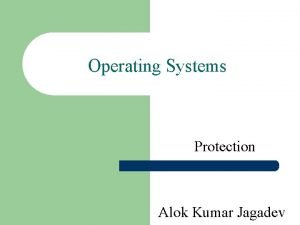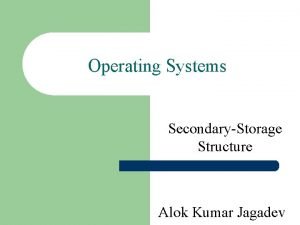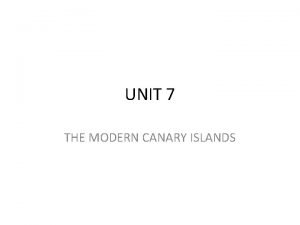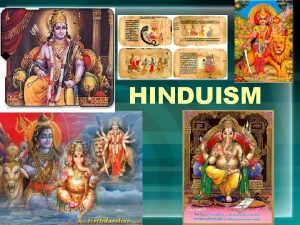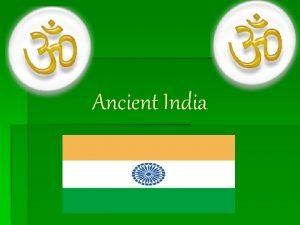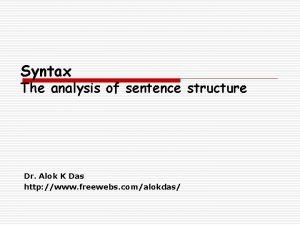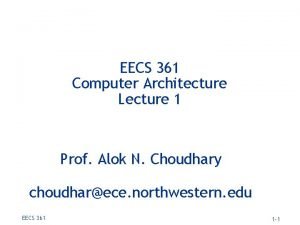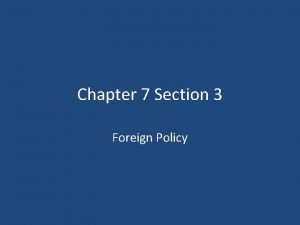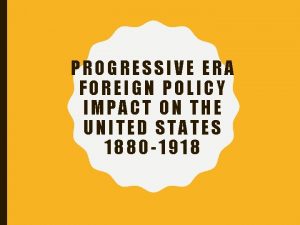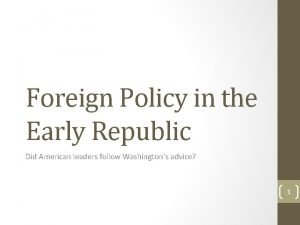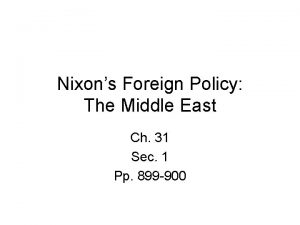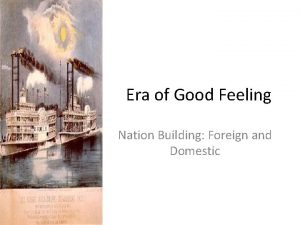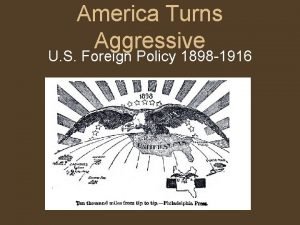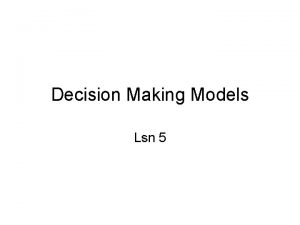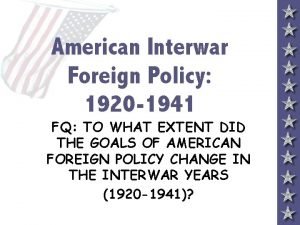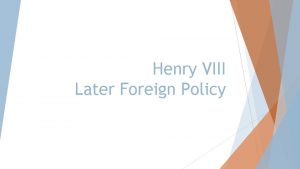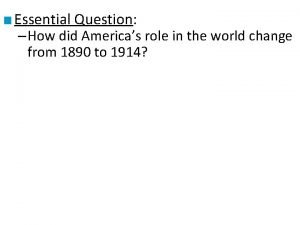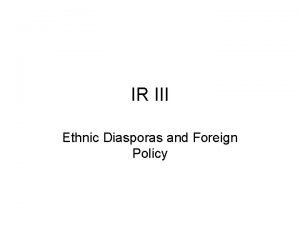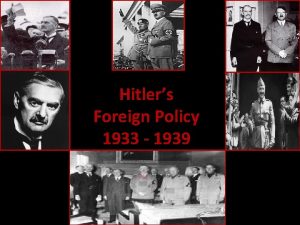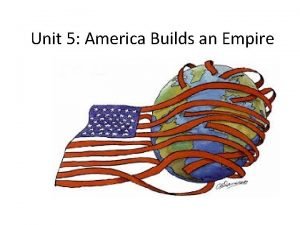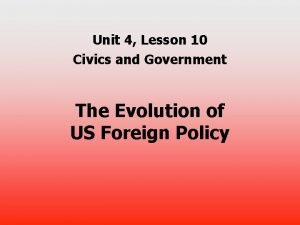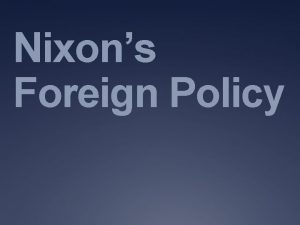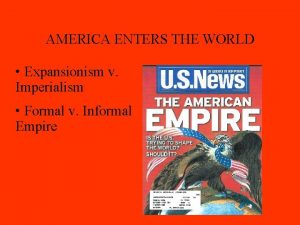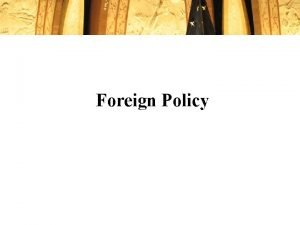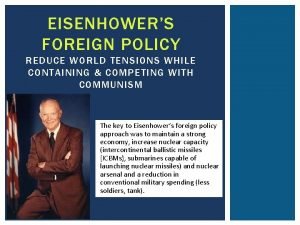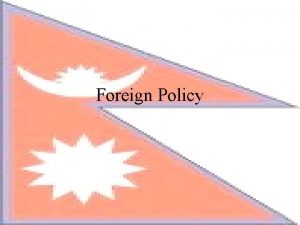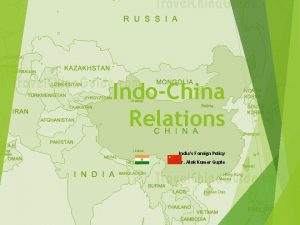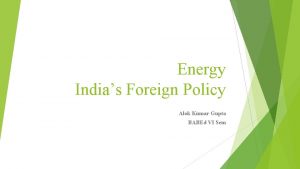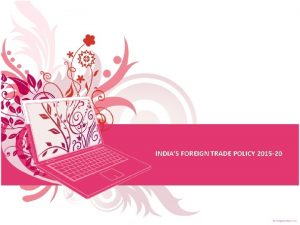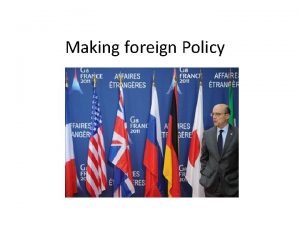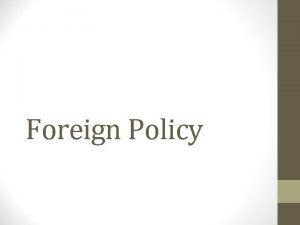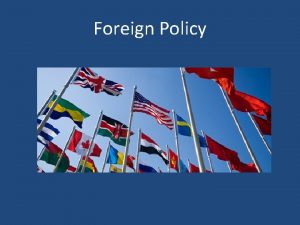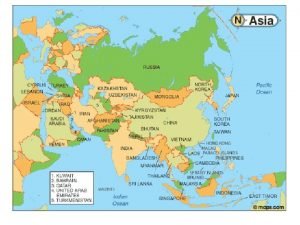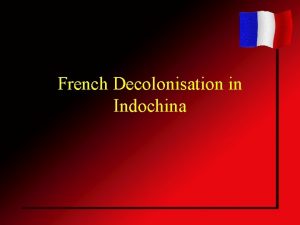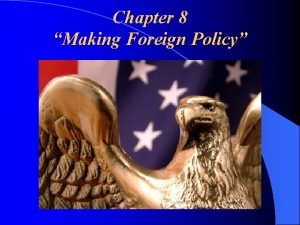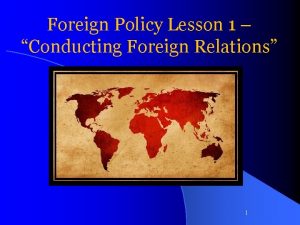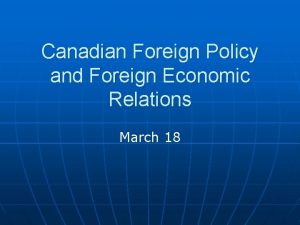IndoChina Relations Indias Foreign Policy Dr Alok Kumar

















































- Slides: 49

Indo-China Relations India’s Foreign Policy Dr. Alok Kumar Gupta

Indicative Resources: Ministry of External Relations website (www. mea. gov. in) Institute of Defence Studies and Analysis (www. disa. in) Institute of Peace and Conflict Studies (www. ipcs. org) Observer Research Foundation (www. orfonline. org) The Diplomat

Historical Perspective India was the first non-communist nation to accord recognition to PRC on April 01, 1950. Established diplomatic relations on the same day.

Jawaharlal Nehru based his vision of resurgent Asia on friendship between the two largest states of Asia; his vision of an internationalist foreign policy governed by the ethics of the Panchsheel (Five Principles of Peaceful Coexistence), which he initially believed was shared by China. Nehru was later disappointed when it became clear that the two countries had a conflict of interest in Tibet, which had traditionally served as a buffer zone, and where India believed it had inherited special privileges from the British Raj.

With Indian support, Tibetan delegates signed an agreement in May 1951 recognizing PRC sovereignty but guaranteeing that the existing political and social system of Tibet would continue. In April 1954, India and the PRC signed an eight-year agreement on Tibet that became the Panchsheel.

Historical Perspective 1950: India was among the first countries to end formal ties with the Republic of China (Taiwan) and recognize the PRC as the legitimate government of Mainland China. The Silk Road not only served as a major trade route between India and China, but is also credited for facilitating the spread of Buddhism from India to East Asia during First Century CE. During the World War II, India and China both played a crucial role in halting the progress of Imperial Japan.

Nehru visited China in October 1954 With Mao Zedong in Pic

Sino-Indian Friendship Association (Founded in Beijing on 16 May 1952)

Since the late 1980 s, both countries have successfully rebuilt diplomatic and economic ties. In 2008, China became India’s largest trading partner and the two countries have also extended their strategic and military relations.

In 2012, China stated its position that “Sino-Indian ties” could be the most “important bilateral partnership of the Century”. [Wen Jiabao, the Premier of China and Manmohan Singh, the Prime Minister of India set a goal to increase bilateral trade between the two countries to US$100 billion by 2015. November 2012 the bilateral trade was estimated to be $73. 9 billion. ]

Indo-China Border Dispute The entire Sino-Indian border (including the western LAC, the small undisputed section in the Centre, and the Mc. Mahon Line in the east) is 4, 056 (2520 miles) long. It traverses five Indian States: Jammu and Kashmir, Uttarakhand, Himachal Pradesh, Sikkim, and Arunachal Pradesh. On the Chinese Side, the line traverses the Tibet Autonomous Region.

The demarcation existed as the informal cease-fire line between India and China after the 1962 conflict until 1993, when its existence was officially accepted as the ‘Line of Actual Control’ in a bilateral agreement. However, Chinese Scholars claim that the Chinese Prime Minister Zhou Enlai first used the phrase in a letter addressed to Indian Prime Minister Jawaharlal Nehru dated 24 October 1959.

Outstanding Issues between India and China Border Dispute: Resulting in Three major military conflicts and two major standoffs: Sino-Indian War of 1962; The Cho La Incident in 1967; Sino-Indian Skirmish in 1986 -87; Daulat Beg Oldi Incident in 2013; Dokalam Standoff of 73 days in 2017.

1. China’s strong strategic bilateral relations with Pakistan; 2. Frequent Chinese military incursions into Indian territory; 3. China has expressed concerns about Indian military and economic activities in the disputed South China Sea. 4. Change in nomenclature from Asia-Pacific to Indo. Pacific 5. Tibetan Refugees 6. River Water Dispute

Territorial Dispute

Aksai Chin (37, 244 square kilometre) Claimed by India as part of the state of Jammu and Kashmir and region of Ladakh but it is controlled and administered as part of the Chinese autonomous region of Xinjiang.

Border Dispute

Aurnachal Pradesh Earlier called as North East Frontier Agency. The easternmost region lies south of the Mc. Mahon Line. The Mc. Mahon Line was part of the 1914 Simla Convention between British India and Tibet, an agreement rejected by China. It is a line agreed to by Britain and Tibet as part of the Simla Accord, a treaty signed in 1914. It is the effective boundary between China and India, although its legal status is disputed by the Chinese government. It extends for 550 miles (890 km) from Bhutan in the west to 160 miles (260 km) east of the great bend of the Brahmaputra River in east, largely along the crest of the Himalayas.

An agreement to resolve the dispute was concluded in 1996, including “Confidence Building Measures” and a mutually agreed Line of Actual Control. In 2006, the Chinese ambassador to India claimed that all of Arunachal Pradesh is Chinese territory amidst a military buildup. At that time both countries claimed incursions as much as a kilometre at the northern tip of Sikkim. In 2009, India announced it would deploy additional military forces along the border.

Contemporary Issues Pakistan Factor: The long-time friendship between China and Pakistan, rooted in a time when both countries were deeply mistrustful of India, has long made India nervous. The relationship has mainly gone way, with China providing economic assistance and political backing to Pakistan.

Pakistan is also anxious for an alliance it can use to balance the growing economic and political clout of India. But Pakistan also offers China a gateway to South Asia, Iran and the Arabian Sea, one of the economic beltways that President Xi Jinping has sought to build through the region. During a visit to Islamabad, Chinese Foreign Minister Wang Yi said China and Pakistan have an “all-weather friendship.

OBOR

Arctic, Land Sea Route of BRI

OBOR (BRI) Having overbuilt in many domestic industries, such as coal, cement, and even solar panels—the Chinese government is redirecting its capital abroad.

The Silk Road Economic Belt (SREB) and the 21 st century Maritime Silk Road, also known as the Belt and Road (abbreviated as B&R), One Belt, One Road (abbreviated as OBOR) or the Belt and Road Initiative is a development strategy and framework, proposed by Chinese paramount leader Xi Jinping that focusses on connectivity and cooperation among countries primarily between the PRC and the rest of Eurasia.

China’s soaring vision envisages once completed Silk Roads, would impact the life of 4. 4 billion people and, within a decade, generate trade above a jaw-dropping $2. 5 trillion. It will bring a paradigm shift in the global economy. An economic roadmap explores the economic topography of seven global regions and profiles 44 individual countries covered by OBOR. [Now from some reports nearly 78 countries]

It consists of two main components, the land-based: Silk Road Economic Belt” (SREB) and Oceangoing “Maritime Silk Road” (MSR). The strategy underlines China’s push to take a bigger role in global affairs, and its need for priority capacity cooperation in areas such as steel manufacturing. Unveiled in September and October 2013. It was also promoted by Premier Li Kequing during the state visit of Asia and Europe.

Anticipated cumulative investment over an indefinite timescale is variously put at US$ 4 trillion to US$8 trillion. OBOR has been contrasted with the two US-Centric trading arrangements, the Trans Pacific Partnership and the Transatlantic Trade and Investment Partnership

The Belt includes countries situated on the original Silk Road through Central Asia, West Asia, The Middle East, and Europe. Another area that is said to be included in the extension of this belt is South Asia and Southeast Asia. North Belt goes from Central Asia, Russia to Europe. Central Belt goes through Central Asia, West Asia to the Persian Gulf and the Mediteranean. South Belt starts from China to Southeast Asia, South Asia, the Indian Ocean. Central Belt is spoken down due to complex religion problems and separation movement along the belt.

The initiative calls for the integration of the region into a cohesive economic area through building infrastructure, increasing cultural exchanges, and broadening trade. MSR is a complementary initiative aimed at investing and fostering collaboration in Southeast Asia, Oceania, and North Africa, through several contiguous bodies of water—the South China Sea, the South Pacific Ocean, and the wider Indian Ocean area. First proposed during a speech by Jinping in Indonesian Parliament October 2013.

The China Pakistan Economic Corridor (CPEC) and the Bangladesh-China-India-Myanmar (BCIM) are officially classified as closely related to the Belt and Road Initiative. In coverage by the media, this distinction is disregarded and the networks are counted as components of the initiative. The CPEC in particular is often regarded as the link between China’s maritime and overland Silk Road, with port of Gwadar forming the crux of the CPEC project.

The AIIB, first proposed by China in October 2013, is a development bank dedicated to leading for projects regarding infrastructure. As of 2015, China announced that over one trillion Yuan ($160 billion US) of infrastructure projects were in planning or construction. AIIB is a multilateral bank that has an authorized capital of US$ 100 billion, 75% of which will come from Asian and Oceanian countries. China will be the single largest stakeholder, holding 26% of voting rights. November 2014, US$40 billion development fund created for the initiative.

India’s Membership to NSG: China has continuously blocked India’s entry in UNSC. Recently China has blocked India’s entry in NSG. Chinese diplomats say Beijing wants NSG entry to be norm-based — in other words, whatever rules govern Indian entry should apply to others too. Norm-based entry would, presumably, help Pakistan gain entry, something many in the NSG are certain to resist because of the country’s record as a proliferator of nuclear-weapons technology to Iran, Libya and North Korea.

The Role of India and China in South China Sea (SCS) The three million square kilometers South China Sea is the maritime heart of Southeast Asia but also a disputable property. Maritime boundaries in the South China Sea are particularly problematic because they involve six separate claimants in a mostly enclosed body of water with a large number of disputed land features. The South China Sea is ringed by Brunei, China, Indonesia, Malaysia, the Philippines, Taiwan, and Vietnam, and dotted with hundreds of small islands, shoals and reefs, many of them occupied by the disputants. The fundamental issue in the South China Sea is one of territorial sovereignty, that is, which state has sovereignty over the islands and their adjacent waters.

China opposes India’s oil exploration in the SCS (which has been undertaken at Vietnam’s request) by calling the area of exploration a ‘disputed’ area and asserting ‘Chinese sovereignty’ over the SCS in the ‘historical’ context. It has been continuously expressing its reservation in this regard in the last few years, and sometimes quite belligerently at that. India has taken note of the Chinese reservation and has carefully gone ahead in signing a few agreements with Vietnam for oil exploration in the SCS.

These exploration fields are very much within the maritime space under the actual control of Vietnam. But at the same time, China casually shrugs off the issue of India’s ‘sovereignty’ over POK in the ‘historical’ context. China is currently engaged on a variety of investment projects and infrastructural building activities in Gilgit-Baltistan, and these will be expanded under the CPEC project. China further explains that the Sino-Pak understanding to implement CPEC through POK is based on a range of bilateral agreements and understandings, including their 1963 Border Agreement.

Indian Ocean and Chinese Increasing Presence: China’s Six fold Legitimate maritime interests: China’s strategic aim is to become a maritime power, which as it says, is to be achieved by pursuing ‘convergence of interests’ with concerned nations. Its sincerity in this regard will come under test in the coming years. Reunifying its offshore islands Safeguarding its territorial waters Assuring its exclusive economic zone for its sole use, reasonably and economically

Protecting high sea collaboratively for global legitimate access Respecting those legitimate maritime rights of other states as per relevant international law; Resolving maritime disputes with other claimants as peacefully as possible when they may arise, while reserving all means for sovereign purpose. The two-protecting high sea and use of all means on sovereignty matters, are striking in importance.

River Water Dispute: The dispute between India and China is mainly regarding the Brahmaputra River flowing through the two countries the search for water resources in China and India has persistently been a source of tension between the two countries. Chinese efforts to divert the water resources of the Brahmaputra River away from India will worsen a situation that has remained tense since the 1962 Indo-China war.

The melting glaciers in the Himalayas as a result of accelerating global climate change will have a dramatic effect on this river’s water supply. This will increase water scarcity as well as the likelihood of floods, impact agrarian livelihoods and strain the fragile equilibrium between the two Asian giants.

CPEC--China Pakistan Economic Corridor: A collection of infrastructure originally project worth US$40 billion is now being pegged at $62 billion. On 13 November 2016, CPEC became partly operational when Chinese cargo was transported overland to Gwadar Port for onward maritime shipment to Africa and West Asia, while some major power projects were commissioned by late 2017.

The SCO and India’s membership: Founded on June 15, 2001, the SCO now has China, Kazakhstan, Kyrgyzstan, Russia, Tajikistan and Uzbekistan as its full members, with Afghanistan, Belarus, India, Iran, Mongolia and Pakistan as observers. India has been accorded status of “Acceding Member” at Tashkent in June 2016. Russia and China has backed India’s membership to SCO. Currently, both India and Pakistan are observers at the bloc. Pakistan applied for a full membership in 2006 and India in 2014.

The SCO has been expanded to Eight Member when India and Pakistan were accorded as Full Members on June 9, 2017 at a Summit in Astana, Kazakhastan.

Doklam

Doklam June 2017 A 73 -days military stand-off took place between India and China, as China attempted to extend a road on the Doklam Plateau southwards near the Doka La Pass and Indian troops moved into prevent the Chinese. India claim to have acted on behalf of Bhutan, with which it has special relationship. Bhutan has formally objected to construction by China in the Disputed Area.

Geopolitical Rivalry Geopolitical rivalry and calibrated cooperation, seemingly antithetical, coexist within the framework of our relationship with China. The latter has pinned its colours to the Pakistani mast as recent developments have demonstrated. It is suspicious about our friendship with the United States, our closeness to Japan, and our naval cooperation in the East and South China Seas with these countries. It challenges us with its myriad dalliances in our neighbourhood.

Indo-China Trade India faces trade imbalance heavily in favour of China. India has a trade deficit with China of nearly $50 billion, its largest with any country. Singapore, with a population about 240 times smaller than India, sells twice as many goods to China each year.

Indo-China Trade

IFP under Narendra Modi’s Modi has said eighteenth century mind-set of vistaar-vad or expansionism won’t work and vikaash-vad or peaceful development is needed for sustainable peace and tranquility in the world which was read by a portion of media as a subtle jibe on China. Narendra Modi has visited China nearly five times since he became Prime Minister of India. Chinese President Xi Jinping has visited twice to India.
 Alok kumar jagadev
Alok kumar jagadev Alok
Alok Alok kumar jagadev
Alok kumar jagadev Too foreign for home
Too foreign for home Indias first empire
Indias first empire Indias religions
Indias religions Flota de indias ruta
Flota de indias ruta Is hinduism the first religion
Is hinduism the first religion Sistemang caste
Sistemang caste Indias first empire
Indias first empire Sociedad colonial americana
Sociedad colonial americana Indias religions
Indias religions Indias first civilization
Indias first civilization The magician touched the child with the wand
The magician touched the child with the wand Dr alok adholeya
Dr alok adholeya Alok kipo mena
Alok kipo mena Alok vijayant
Alok vijayant Alok mohan
Alok mohan Alok gupta md
Alok gupta md Cache do alok
Cache do alok Foreign policy vocabulary
Foreign policy vocabulary Pros and cons of big stick diplomacy
Pros and cons of big stick diplomacy Foreign policy in the early republic
Foreign policy in the early republic Nixons foreign policy
Nixons foreign policy Foreign policy
Foreign policy President taft’s foreign policy emphasized
President taft’s foreign policy emphasized Actors in foreign policy
Actors in foreign policy Interwar america
Interwar america Foreign policy of louis philippe
Foreign policy of louis philippe What policy did the qing adopt regarding foreign trade?
What policy did the qing adopt regarding foreign trade? Foreign policy shift
Foreign policy shift Henry viii foreign policy 1509-1529
Henry viii foreign policy 1509-1529 Foreign policy imperialism
Foreign policy imperialism Actors in foreign policy
Actors in foreign policy When was the league of nations created
When was the league of nations created Foreign policy
Foreign policy Lesson 5 american foreign policy
Lesson 5 american foreign policy Unit 4 lesson 10 american foreign policy
Unit 4 lesson 10 american foreign policy What was thomas jefferson foreign policy
What was thomas jefferson foreign policy Foreign policy apush
Foreign policy apush Foreign policy
Foreign policy Whats vietnamization
Whats vietnamization Foreign policy imperialism
Foreign policy imperialism Definition of foreign policy by scholars
Definition of foreign policy by scholars Eisenhowers foreign policy
Eisenhowers foreign policy John foster dulles apush
John foster dulles apush Hitler's foreign policy timeline
Hitler's foreign policy timeline Nixons foreign policy
Nixons foreign policy Expansionist synonym
Expansionist synonym What is foreign policy analysis
What is foreign policy analysis
